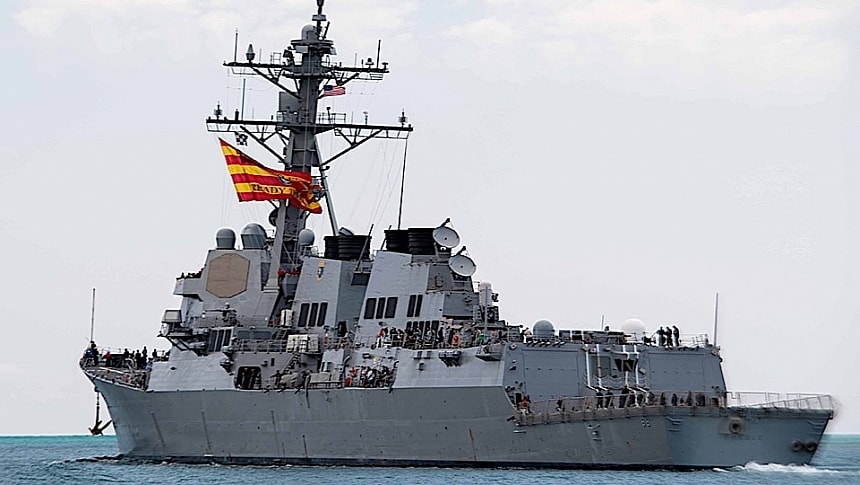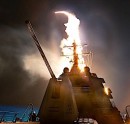It was kind of a hot weekend over in Hawaii, where the U.S. Navy and three of America's prime defense contractors (Raytheon, Northrop Grumman, and Lockheed Martin) came together for an impressive weapons test.
The star of the exercise was the most recent configuration of the integrated defense capability the world has come to know as the Aegis. Officially called Flight Test Aegis Weapon System (FTM)-32 Baseline 9.C2, the technology was put through its paces at the Pacific Missile Range Facility, on Kauai in Hawaii.
Two Navy ships were in the water for the test, both of them Arleigh Burke-class guided-missile destroyers: the USS Preble (DDG 88) and the USS Jack H. Lucas (DDG 125). As far as we understand, only the Preble was an active participant in the test, as the Lucas is equipped with the Aegis Baseline 10.
Baseline 9 is a variant of the Aegis that according to its maker, Lockheed Martin, "improves tracking, identification and intercept capabilities to solve for evolving, complex threats."
From somewhere in the region, the U.S. Navy launched a medium-range ballistic missile target aptly called Medium-Range Ballistic Missile Type 3 Configuration 2 (MRBM T3c2) Target Vehicle (quite a mouthful, I know).
The thing is made by Northrop Grumman and comes as a two-stage, solid rocket-fueled ballistic missile that is "threat-representative."
The goal of the test was to see if the Aegis could detect, track, and intercept the ballistic missile in a critical stage of its operation, in the terminal phase of its flight – that is, right before striking its target.
The defense system on the USS Preble engaged as predicted, and fired a Standard Missile-6 (SM-6) at the other missile the Navy fired. The target was intercepted "in its final seconds of flight."
SM-6 is the work of Raytheon which proudly describes it as the only one of its kind. What that means is this is the only over-the-horizon ship-borne weapon that can be used to defeat targets moving both in the air or on the surface of the water.
The defensive weapon was in a configuration called Dual II (Block IA), which means it packed "newly qualified software that increases" its capabilities. What exactly that means is, of course, kind of a secret and not made for our eyes, but it was exactly these capabilities that were put to the test.
As per Raytheon, the anti-ballistic missile test announced this weekend was the seventh of its kind for the SM-6, and the fourth for the weapon in this configuration.
The success of the test was publicly announced in part because the Department of Defense approved the sale of the SM-6 missiles to a number of allied countries, including South Korea, at the end of last year.
Two Navy ships were in the water for the test, both of them Arleigh Burke-class guided-missile destroyers: the USS Preble (DDG 88) and the USS Jack H. Lucas (DDG 125). As far as we understand, only the Preble was an active participant in the test, as the Lucas is equipped with the Aegis Baseline 10.
Baseline 9 is a variant of the Aegis that according to its maker, Lockheed Martin, "improves tracking, identification and intercept capabilities to solve for evolving, complex threats."
From somewhere in the region, the U.S. Navy launched a medium-range ballistic missile target aptly called Medium-Range Ballistic Missile Type 3 Configuration 2 (MRBM T3c2) Target Vehicle (quite a mouthful, I know).
The thing is made by Northrop Grumman and comes as a two-stage, solid rocket-fueled ballistic missile that is "threat-representative."
The goal of the test was to see if the Aegis could detect, track, and intercept the ballistic missile in a critical stage of its operation, in the terminal phase of its flight – that is, right before striking its target.
The defense system on the USS Preble engaged as predicted, and fired a Standard Missile-6 (SM-6) at the other missile the Navy fired. The target was intercepted "in its final seconds of flight."
SM-6 is the work of Raytheon which proudly describes it as the only one of its kind. What that means is this is the only over-the-horizon ship-borne weapon that can be used to defeat targets moving both in the air or on the surface of the water.
The defensive weapon was in a configuration called Dual II (Block IA), which means it packed "newly qualified software that increases" its capabilities. What exactly that means is, of course, kind of a secret and not made for our eyes, but it was exactly these capabilities that were put to the test.
As per Raytheon, the anti-ballistic missile test announced this weekend was the seventh of its kind for the SM-6, and the fourth for the weapon in this configuration.
The success of the test was publicly announced in part because the Department of Defense approved the sale of the SM-6 missiles to a number of allied countries, including South Korea, at the end of last year.









